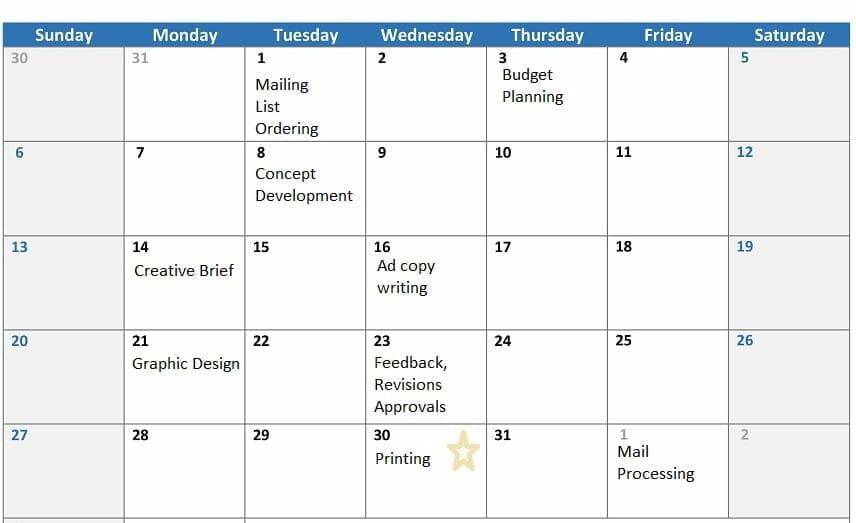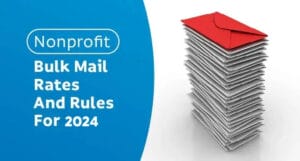Listen to This Audio to Get a Full Overview in Two Minutes:
That’s why it’s important to start planning your direct mail marketing campaigns for the year in December and January. Your marketing schedule for the year can make or break your campaign’s success. Planning will help you set goals and avoid becoming overwhelmed and disorganized as the year progresses.
Understanding the Importance of Direct Mail
Here are some important reasons why you should include direct mail in your marketing plan:
- Tangible and Personal: Direct mail marketing campaign plan provides a physical touchpoint with your audience, allowing them to engage with your brand more personally. It stands out among the digital noise and can leave a lasting impression.
- Targeted Approach: Direct mail lets you precisely target specific demographics or geographic locations, ensuring your message reaches the right people.
- Higher Response Rates: Research indicates that direct mail frequently generates a higher response rate than digital marketing. This is because it can stimulate a sense of urgency and provoke a more powerful emotional reaction, increasing conversions.
Benefits of Early Direct Mail Planning:
- Strategic Decision-Making: Early planning lets you carefully consider your objectives, target audience, messaging, design, and distribution strategy. This strategic approach ensures that your direct mail campaign aligns with your marketing goals.
- Budget Allocation: Planning ahead enables you to allocate your marketing budget effectively. By considering the costs associated with printing, postage, and design, you can avoid last-minute financial constraints and negotiate better deals with vendors.
- Production Timelines: Direct mail campaigns involve multiple stages, including design, printing, and fulfillment. Planning allows you to account for the necessary lead times at each stage, ensuring your materials are ready to be delivered when needed.
- Data Management: Effective direct mail campaigns rely on accurate and up-to-date data. Starting early gives you ample time to clean and segment your mailing lists, ensuring your messages reach the right individuals.
Here are a few tips to start your direct mail planning
- Review past campaigns: Look at your direct mail campaigns from previous years. Assess what worked well and what could be improved. Identify successful strategies and areas that need adjustment based on the results. Use these insights to inform your planning for the upcoming year.
- Define your target audience: Identify your target audience for each direct mail campaign. Understand their demographics, preferences, and pain points. This will help you tailor your messaging and design to resonate with them effectively.
- Set specific goals: When creating direct mail marketing campaign plan that align with your business objectives, such as lead generation, sales, brand awareness, or promoting a new product, set specific goals. Ensure they are measurable to track progress.
- Determine your budget: Allocate a realistic budget for your direct mail campaigns. Consider the costs of printing, design, mailing lists, postage, and any additional services you may require. Ensure that your budget is aligned with your goals and expected ROI.
- Plan your campaign schedule: Set a schedule for each direct mail campaign, including the start and end dates and any important milestones. Consider key events, holidays, or seasonal trends that may impact the timing of your campaigns.
- Develop compelling creative content: Invest time and effort into creating engaging and persuasive content for your direct mail pieces. Craft attention-grabbing headlines, compelling copy, and visually appealing designs that align with your brand and campaign objectives.
- Build a quality mailing list: Regularly update and maintain your mailing list to ensure accuracy and relevance. Consider using data-driven strategies to segment your audience and personalize your mailings for better response rates.
- Test and track results: Implement A/B testing and track the performance of your direct mail campaigns. Test elements such as headlines, offers, design variations, or mailing formats to identify what resonates best with your audience. Analyze the results and make data-driven adjustments to optimize future campaigns.
- Leverage technology and automation: Explore tools and software that streamline your direct mail processes, such as print-on-demand services, CRM integrations, and automation platforms. These can help save time, improve accuracy, and enhance the overall efficiency of your campaigns.
- Monitor industry trends: Stay updated on the latest trends and innovations in direct mail marketing. Follow industry publications, attend relevant conferences or webinars, and network with other professionals to gain insights and inspiration for your direct mail marketing plan.

Strategic Timeline Breakdown for Effective Campaigns:
Regarding direct mail campaigns, meticulous planning is the cornerstone of success. At Accurate Mailing Services, we understand the importance of a well-executed timeline to ensure maximum impact and outstanding results. To help you outrank the competition and achieve your marketing goals, we have prepared a detailed breakdown of the timeline for your direct mail marketing campaign plan.
Step 1: Mailing List Research and Acquisition (1-3 Days)
A successful direct mail marketing plan starts with a targeted and well-researched mailing list. Our experts invest 1-3 days researching list sources, requesting reports, conducting profiling, cleaning the data, and acquiring additional contacts. This meticulous approach ensures that your campaign reaches the right audience for optimal engagement and conversion.
Step 2: Budgeting for Success (1-2 Days)
To make the most of your direct mail investment, it’s crucial to establish a clear budget aligned with your business targets and available resources. We dedicate 1-2 days to requesting and approving estimated costs, carefully considering the various elements such as printing, design, mailing services, and postage expenses. By effectively managing your budget, we help you achieve a high return on investment.
Step 3: Concept Development and Goal Setting (2-4 Days)
Before diving into the creative process, brainstorming ideas and defining your campaign’s goals is essential. On average, we spend 2-4 days collaborating with you to establish a clear vision and direction. By aligning our efforts with your objectives, we create a campaign that resonates with your target audience and delivers tangible results.
Step 4: Crafting the Creative Brief (1-3 Days)
Accurate Mailing Services focuses on developing a comprehensive creative brief to ensure a smooth and efficient workflow. This document is a project overview, capturing key deliverables, essential selling points, and critical details necessary for timely completion. Our team dedicates 1-3 days to ensure that everyone involved is on the same page, fostering clarity and collaboration throughout the campaign.
Step 5: Professional Ad Copywriting (1-2 Days)
Crafting compelling ad copy is a cornerstone of an effective direct mail campaign. Whether your mailpiece requires a concise 100-word message or several pages of content, our professional writers deliver an engaging and persuasive copy. We allocate 1-2 days to ensure your message captivates your audience and drives them to act.
Step 6: Creative Graphic Design (3-5 Days)
We understand the power of visually captivating designs in direct mail campaigns. Our creative team dedicates 3-5 days to developing original artwork incorporating a strong and creative concept aligned with your brand identity. By allowing ample time for Graphic design, we ensure that your mailpiece stands out and leaves a lasting impression.
Step 7: Feedback, Revisions, and Approvals (5-7 Days)
While revisions are a natural part of the creative process, balancing perfection and efficiency is essential. Our process is collaborative. We encourage feedback and offer multiple revisions per project. By allocating 5-7 days for this phase, we ensure your campaign progresses smoothly, avoiding unnecessary delays.
Step 8: Printing and Personalization (4-7 Days)
The printing and personalization stage is critical in bringing your direct mail materials to life. Depending on the complexity of the formats, we ensure efficient printing within 4-7 days for the direct mail marketing campaign plan. While postcards can be printed relatively quickly, more complex formats may require additional time. We also focus on personalization, tailoring each mailer to the recipient for a personalized touch that drives engagement.
Step 9: Meticulous Mail Processing and Delivery (2-3 Days)
We understand the importance of precise mail processing to ensure the timely delivery of direct mail ideas. Our team handles addressing, folding, envelope inserting, tabbing, stamping, and dropping off at the post office. We allocate 2-3 days for this process, ensuring your direct mail campaign is accurately processed and ready for prompt delivery.
Step 10: Delivery Timeframes (3-4 Days for First Class, Up to 3 Weeks for Standard or Bulk Mail)
When you mail with Accurate Mailing Services, you can monitor your mail. With each campaign, you receive a website link that tracks your mail every 60 seconds! You can search for a single mailpiece and track it to the delivery location using Google Maps©. When it comes to delivery, the chosen mailing class determines the timeframes. With first-class mail, delivery is about 1-5 days, providing a great option for time-sensitive campaigns. Marketing Mail, often called bulk mail, is less expensive, and delivery times vary from 3-21 days. At Accurate Mailing Services, we consider these timeframes when planning your campaign launch and setting recipient expectations.




